Winter Camouflage – PenCott Snowdrift
Introduction
Even though most of the snow is already gone, I am going to continue the winter camouflage series. In this field test, I will be focusing on PenCott Snowdrift. As I was doing this series, Dominic Hyde, the developer of the PenCott patterns, quickly reached out and provided me with a set of PenCott’s winter pattern – Snowdrift. This has been hard to come by in recent years, as the market changed and I was curious to finally get some into my hands and try it out
Unfortunately the weather had already changed and I was struggling to recreate a similar set of pictures as in the first two tests, especially since most of the snow had already melted away.
Nevertheless, let’s jump right into the presentation of the pattern itself, before looking at its performance.
PenCott Snowdrift
PenCott Snowdrift “was specifically designed to provide superior camouflage in a wider range of snow-covered terrain.” As such it follows the 3-in-1 / 360° pattern geometry design of the PenCott patterns, using depth, disruption and blending in effects.
Besides the white color, Snowdrift features light grey tones in combination with coyote spots. The latter aim to mimic brown vegetation like grass, which might stand out in snow plains.
Other than its siblings Badlands, Greenzone, Metropolis etc. it is less pronounced in its contrast, to better blend into snow environments.
With that being said, let’s continue with the methodic remarks, which you can skip if you are a returning reader.
Methodic Remarks
As always I want to point out several important aspects beforehand. First of all, I do not claim any scientific standard with my camouflage comparisons. I also conduct them with my best knowledge and the available resources.
The pictures are usually taken at the same locations I always use for my camouflage comparisons. That way you can compare the various field tests I have done so far with each other. Recently my main spot was completely lost to deforestation, so I had to add a new location.
Before I start, please consider the following – as always:
I did not edit the pictures in any special way, except the following:
- Lens correction
- Watermark
- Blurred my face out if necessary
- .jpeg compression to make it web compliant
- I always do a proper white balance to make colors appear the way they are.
A short explanation to the environment and the procedure:
The pattern was tested in a Central European forest environment. Information about the various locations will be stated in the subsections. The pictures usually portray three different positions:
- Standing in the open (to get an idea of the pattern in this particular surroundings and if the colors match it).
- Kneeling.
- The prone position (to mimic basic, up to ideal concealment without using enhancements).
As always I photographed the pattern with a wide angle lens at first and then with 35mm focal length, which mimics the actual picture the human eye would perceive at this distance. Having in mind the three different positions mentioned before, I usually end up with 6 pictures of each location.
Furthermore:
Given the amount of pictures in my field tests, I will continue with my modus operandi from previous camo reviews and not describe or comment on each picture. Instead I will give a more thorough analysis at the end of each subsection.
With that being said, let’s take a closer look at the pictures themselves.
PenCott Snowdrift
Location 1c
When it comes to some of my locations, I am out of luck. My main location (Location 1) was cut down on a large basis. I decided to replace this one with a site right next to Location 2 in a different direction. However, When I was shooting the pictures with PenCott Snowdrift, this location was basically snowless, as it was directly exposed to the sun. As a result I had to change plans again, and after trying out different spots I settled with Location 1c.
It is in a typical European mixed forest as well, with a high foliage canopy directly above, some basic underbrush on the ground, and with an opening in the background.
As the snow was not as deep as in the previous field tests, the dominant color was not white anymore. While the background in the opening was still covered in snow and exposed to direct light, it is the dominant factor in the pictures. The rest of the area is full of tree trunks and cut branches contrasting the picture.
These pictures were taken before noon under a clear sky. As a result the morning sun directly hit portions of the snow, making it brighter than other spots
The camera is standing roughly 10m away from the human silhouette.
Observations – Location 1c
Location 1c depicts two extremes – on the one hand a bright and illuminated open snow area in the back, as well as underbrush in the front. Looking at the pictures taken with the wide angle lens, one can see how PenCott Snowdrift blends in into the close vicinity and the branches, but at the same time stands out, as the backdrop is sun lit and bright white. As a result the silhouette of the upper body is clearly visible, while the body beneath the waist blends in nicely with the immediate surroundings.
At the same time the midi and macro elements of the pattern are visible, breaking up the white color of PenCott Snowdrift. When kneeling down, the reason for the brown elements in the pattern becomes clear. While they not only prevent a too obvious solid color white surface, they also work quite well in mimicking dead vegetation, especially high grass and branches.
Both pictures taken with 35mm focal length give a better idea about the statement above. The upper body is contrasting with the white, sun lit background, even though it features enough white to blend in. At the same time the pants merge with the underbrush of the location, as the midi elements in brown and gray work well in blending in.
The second picture in the kneeling position speaks for itself, or better said: the above mentioned statements apply.
Location 2
This location is known from previous tests. It is a mixture of deciduous and coniferous forest. It changed, as there is a huge pile of cut branches on one side at the moment. Since most of the leaves fell off during autumn and winter, visibility is better and you can see further back. The snow cover is not as extensive anymore, in comparison to the last two tests and you can see in the background that the snow has already begun to melt away.
The pictures were taken before noon under a clear sky and the sun came over the hill already. This had the effect that the background was much brighter and the foreground still dark and in shadows, making it difficult for me to blend in as there is much more contrast.
The camera is standing roughly 15m away from the human silhouette.
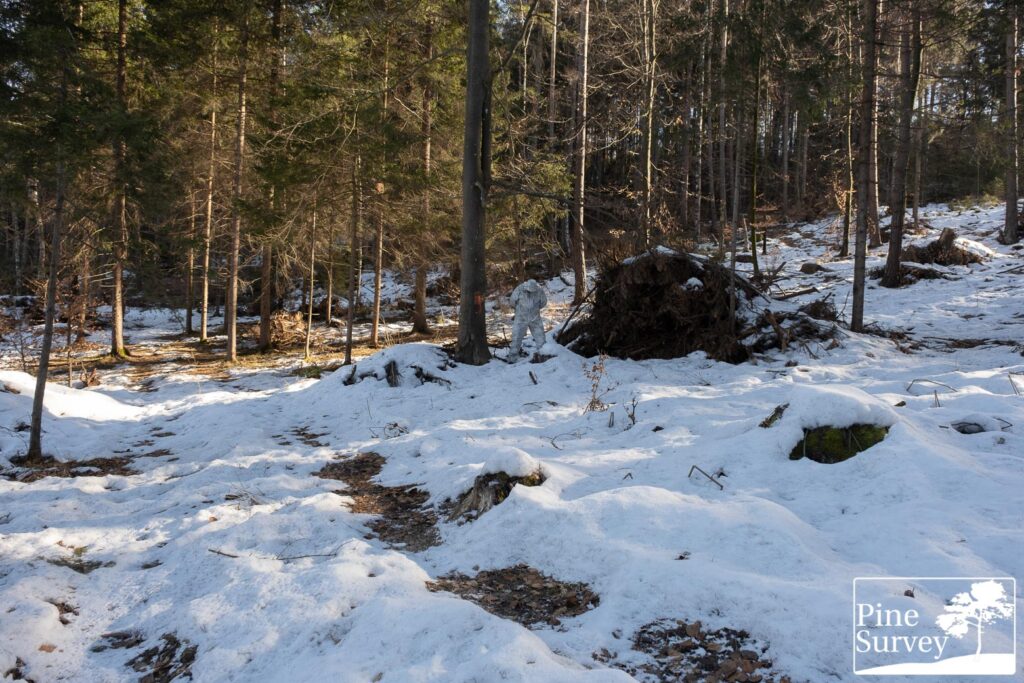
wide angle lens – standing position – 15m distance 
wide angle lens – kneeling position – 15m distance 
wide angle lens – prone position – 15m distance 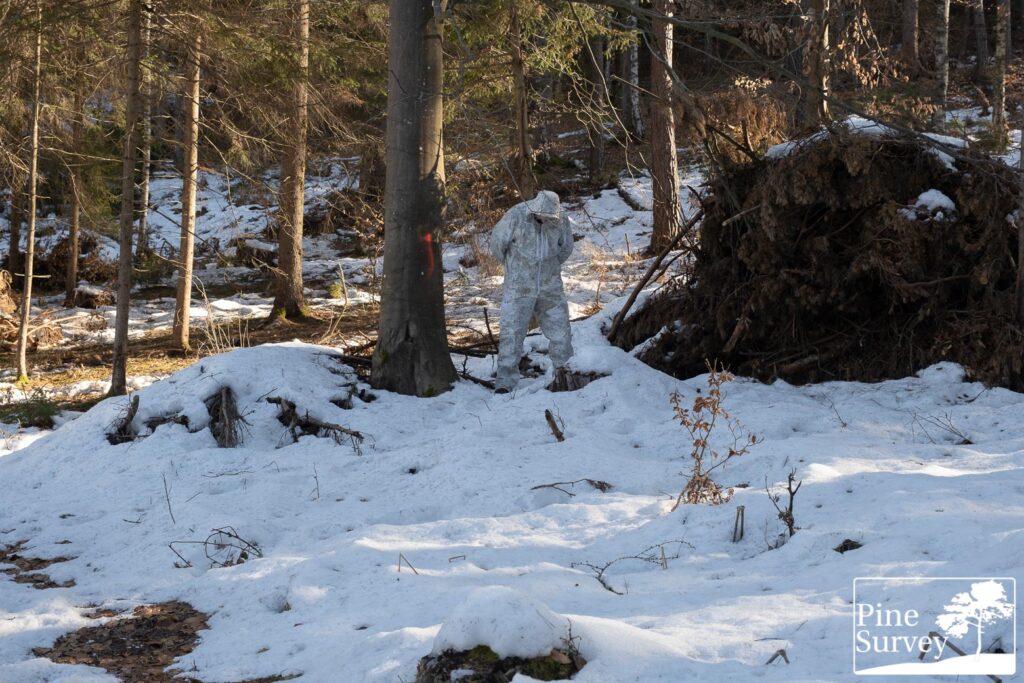
35mm focal length – standing position – 15m distance 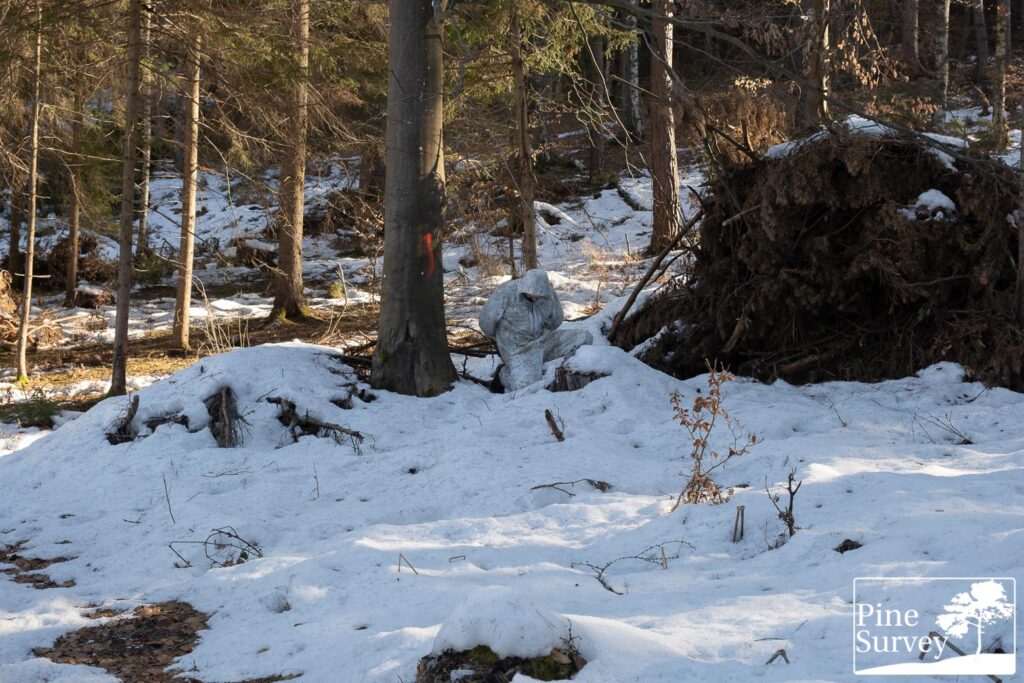
35mm focal length – kneeling position – 15m distance 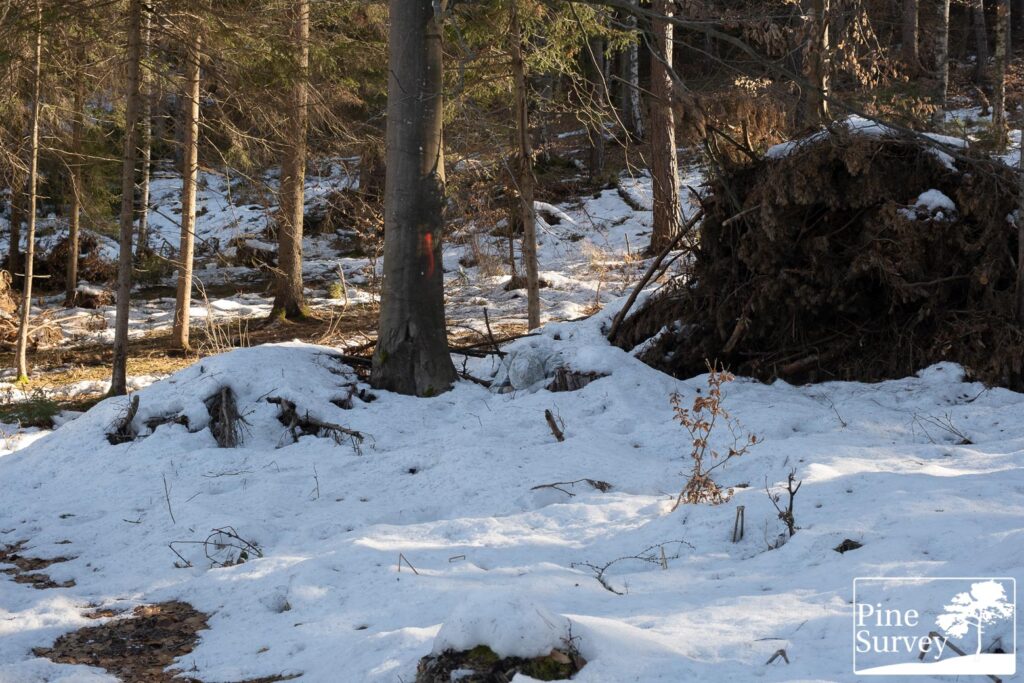
35mm focal length – prone position – 15m distance
Observations – Location 2
The wide angle lens in combination with the standing position gives a clear picture of the silhouette, because of the warm sun beams in the background and the contrasting cold colors in the front. However, one can see the brown macro elements of PenCott Snowdrift at work, matching with the brown vegetation in the background. The gray midi elements in combination with the overall white color, do their best to blend in in this exposed position.
When kneeling down, one can immediately see the change. The blending effect with the background becomes way better, and the midi and macro elements are close to the white surroundings and the dead vegetation. Positioning and light fit better, making a point in the importance of awareness in such matters. At the same time it gives an idea of the potential of PenCott Snowdrift, in heavier snow environments.
This argument is underlined, when looking at the prone position. In a complete snow cover, the pattern blends in nicely offering white areas which are not too obvious and which also feature disrupting midi elements on a basic scale.
The pictures with 35mm focal length give a better idea of the actual distance. In the standing position one gets a good impression of the midi and macro fractals in the pattern. If the sunlight would not provide a warm contrast in the background, the colors would actually match the brown underbrush with the minimal snow. In this situation however, the silhouette is visible for obvious reasons even though the colors would be ideal for a snow environment.
Changing to the kneeling position improves the situation, as mentioned above. In this case the partially visible face is an immediate give away.
The prone situation does not need further explanation, as it was already described. However, the midi elements are more visible in this case, as is my hand.
Location 3
This site is an open field in a mixed forest, with random conifers, some deciduous trees as well as high grass. As already mentioned in previous reviews, I changed the perspective here, since the vegetation started to obstruct the field of view.
The location is not as heavily covered with snow as before, but the snow surface is only interrupted where the vegetation breaks through. The setting is a chaotic field, mixed with monotone whites and a wide range of disrupting dark areas of branches and evergreen trees. These pictures were taken in the late afternoon under a cloudless sky so it offers the best comparison to previous tests, even though there is less snow.
The camera is standing roughly 25m away from the human silhouette.
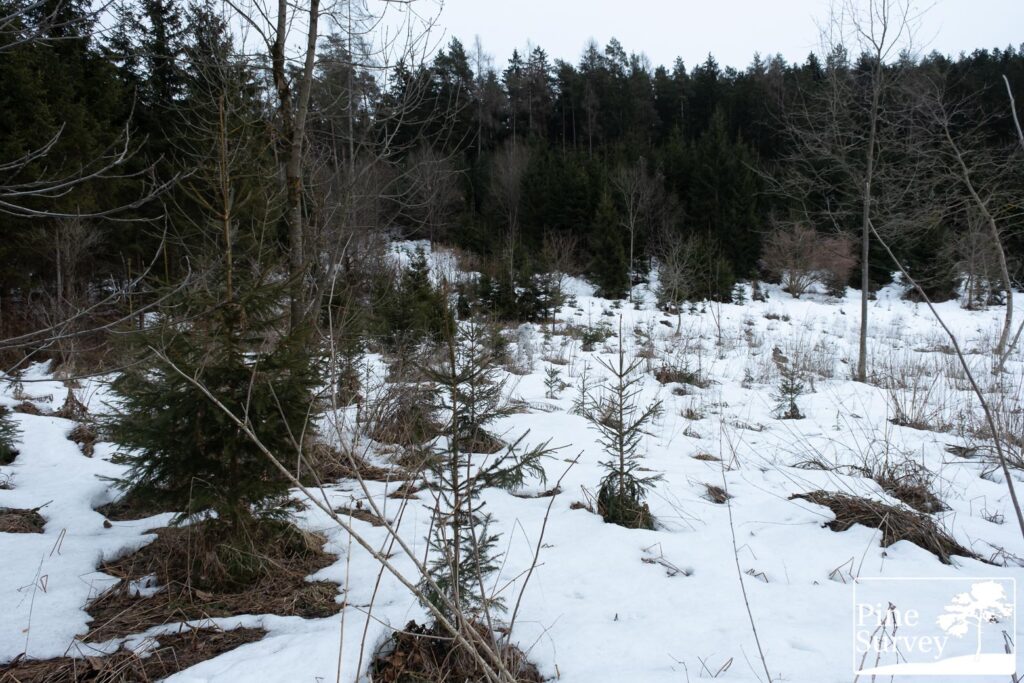
Wide angle lens – standing position – 25m distance 
Wide angle lens – kneeling position – 25m distance 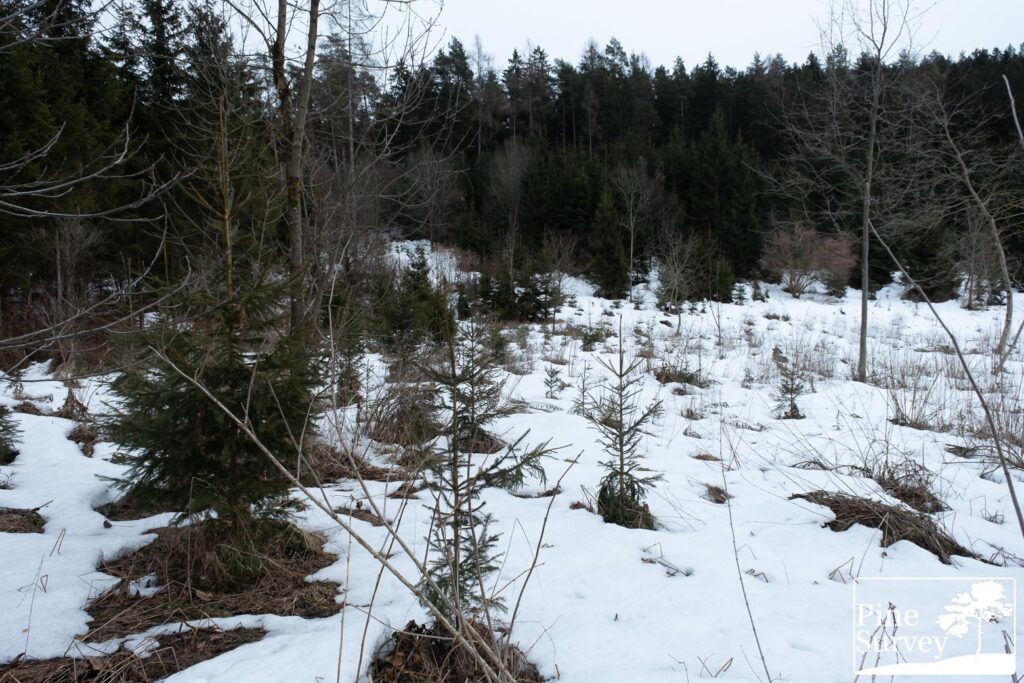
Wide angle lens – prone position – 25m distance 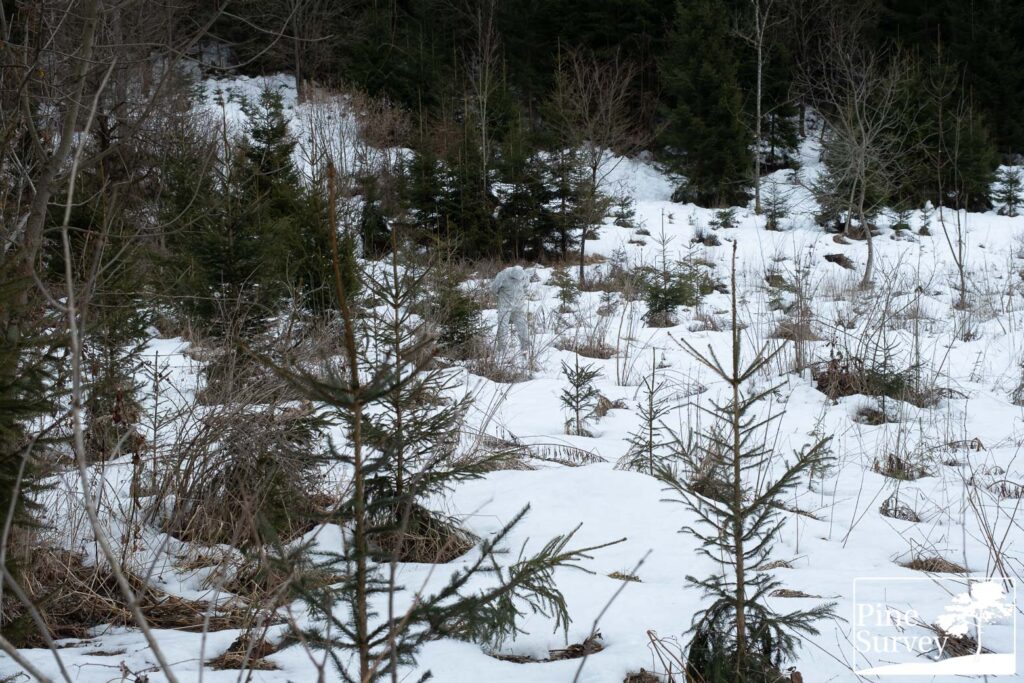
35mm focal length – standing position – 25m distance 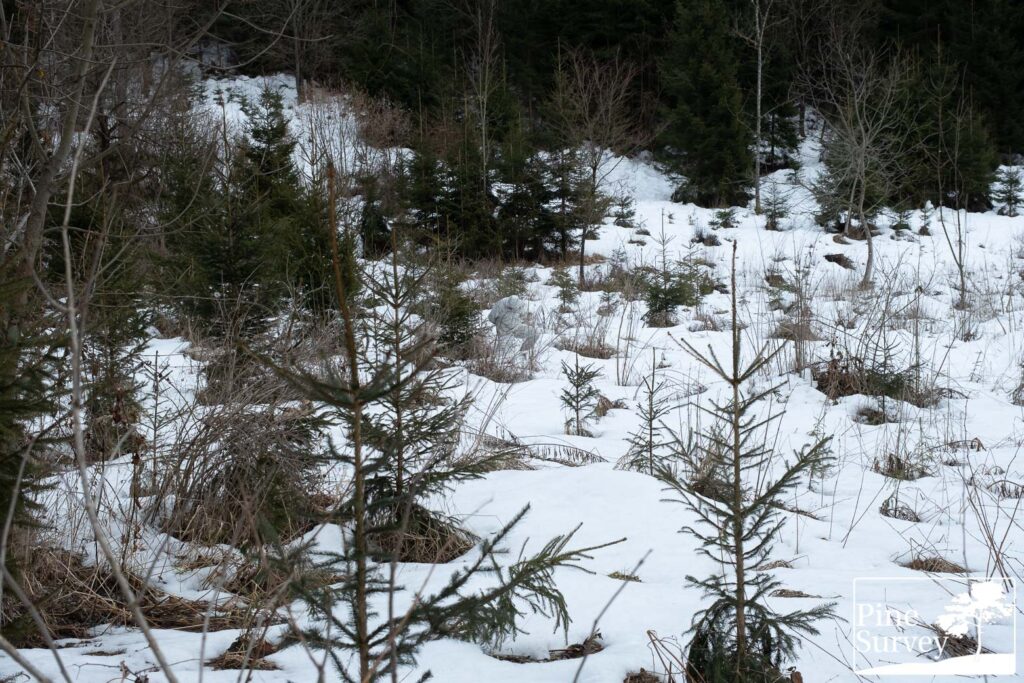
35mm focal length – kneeling position – 25m distance 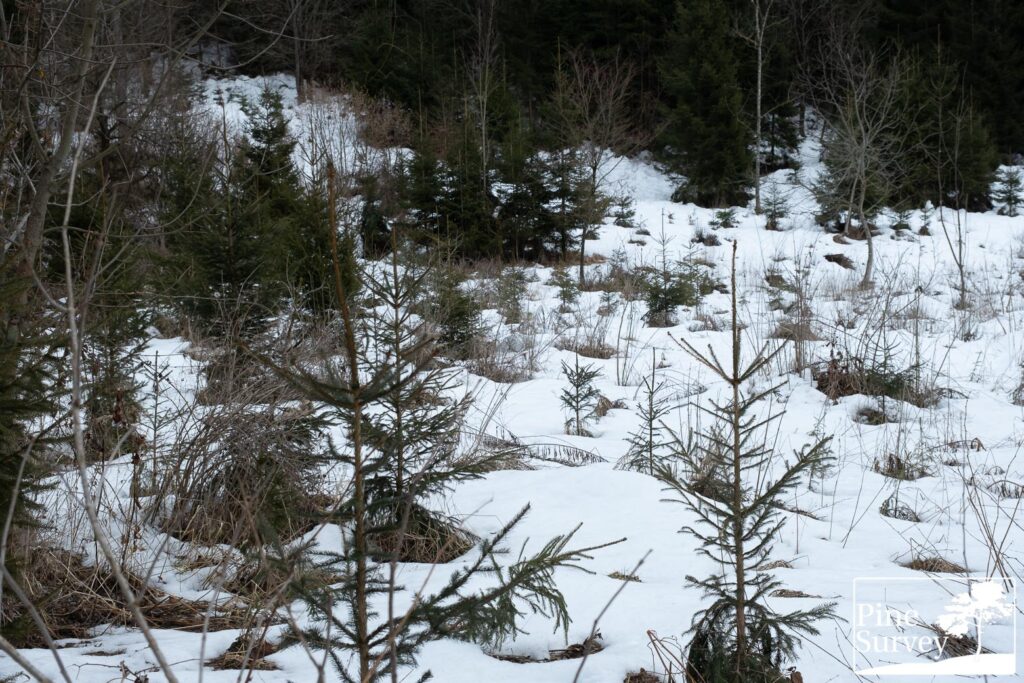
35mm focal length – prone position – 25m distance
Observations – Location 3
In this more typical winter setting, the pictures of both the wide angle lens as well as the 35mm focal length show the performance of PenCott Snowdrift not in a worst case scenario for once. Starting with the wide angle and the standing position, one can see the midi and macro elements at work. The overall appearance is not to white and the pattern blends in well into the surroundings, despite the contrasting brown and green background.
Especially when kneeling, the brown elements of PenCott Snowdrift come into play, as they are a perfect match to high grass as well as branches, which break through snow surfaces. One can see the macro elements breaking up the silhouette, while the white does the rest in blending in. The prone position speaks for itself. Not only because it is the best way to conceal in a horizontal field of view, but also as the pattern blends in nicely with its surroundings.
Looking at the pictures with 35mm focal length, one gets a better idea of the brown fractals in the pattern. Especially when kneeling down, it becomes apparent once more, why the color was used in this pattern. The blending in effect with the dead grass and branches works really well, even though the white in the pattern could be more dominant at times.
Especially when in the prone, the camouflage effect is excellent, as the midi and macro elements interact with the vegetation.
Addendum
As I was running around looking for a suitable replacement of Location 1 and also in between takes when the weather changed too rapidly, I took several other pictures, which show PenCott Snowdrift in ideal environments. This is meant as a supplement, as the actual field test was troubled by the lack of snow as well as difficult light settings.
Conclusion
Coming to an end, several things are worth noting. This field test not only displayed the performance of PenCott Snowdrift, but also highlighted the issues of snow surface, and light and why winter camouflage is as tricky as urban camouflage: because of rapidly changing environments. When a clouded and heavy snow surface is available, snow camouflage makes the most sense and is also the most effective, no matter which pattern. As soon as the snow surface is breaking up, other camouflage solutions are more favorable (Phantomleaf WASP II Z3B or Finnish M05 Winter Camo comes to mind – do not mistake it with M05 Snow Camo).
When it comes to closed snow surfaces, dominant white areas with minimal vegetation breaking through, PenCott Snowdrift shines with an excellent performance, given its dominant white appearance with minimal brown and gray tones in it. The latter provide enough disruption in the white, to not make it a plain white surface, which would only make sense in an arctic or alpine environment.
The added pictures, which are more the social media content type pictures, do show several situations in which PenCott Snowdrift really shines. Especially the needles on the ground were an eye opener for me, but also its performance in a deciduous forest, with plenty of brown beech leaves on the ground.
Given its performance, it will be interesting to see if there will be more products in PenCott Snowdrift in the future. Rumors have it, there will be more to come from a British printer, but we will learn soon enough.
With that being said, many thanks to PenCott for making this review possible! And thank you for reading!
Take care!
If you want to support content like this, please consider leaving a small donation!

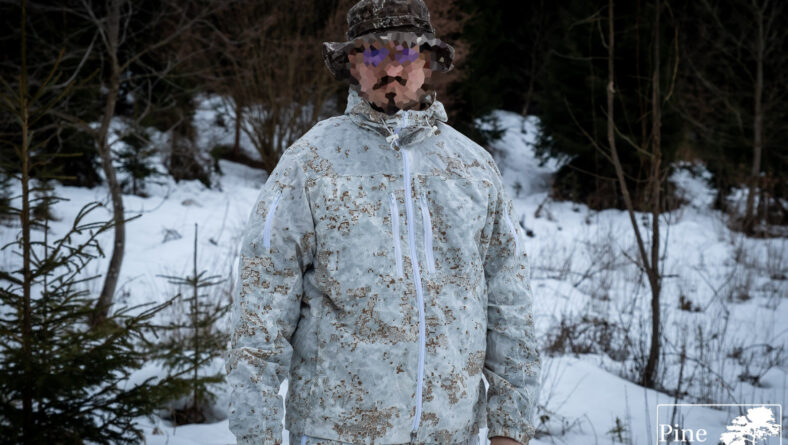
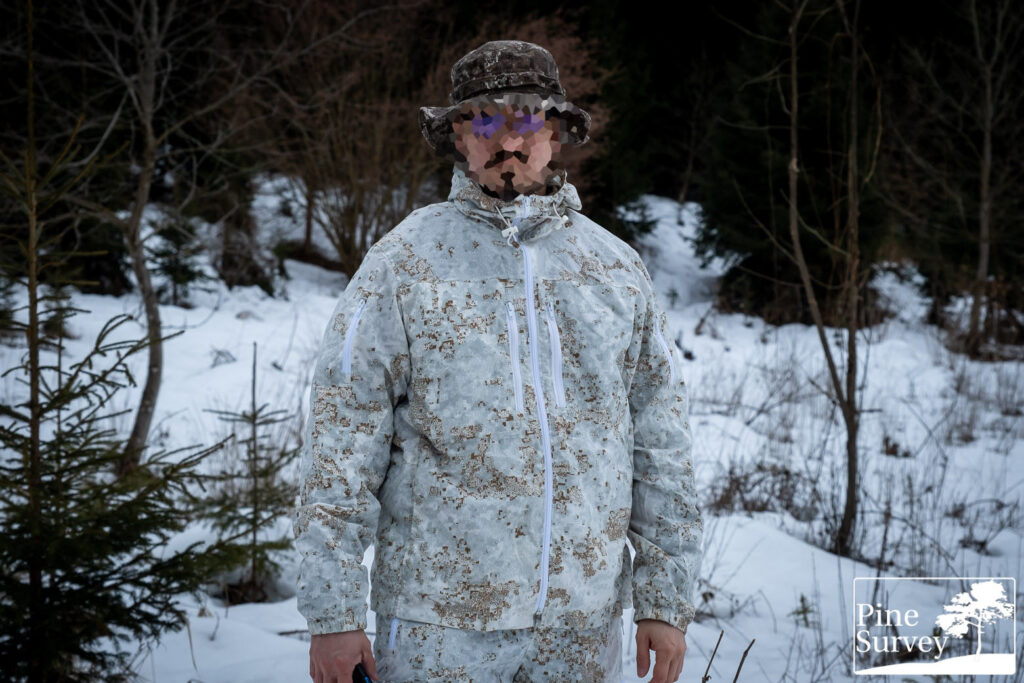
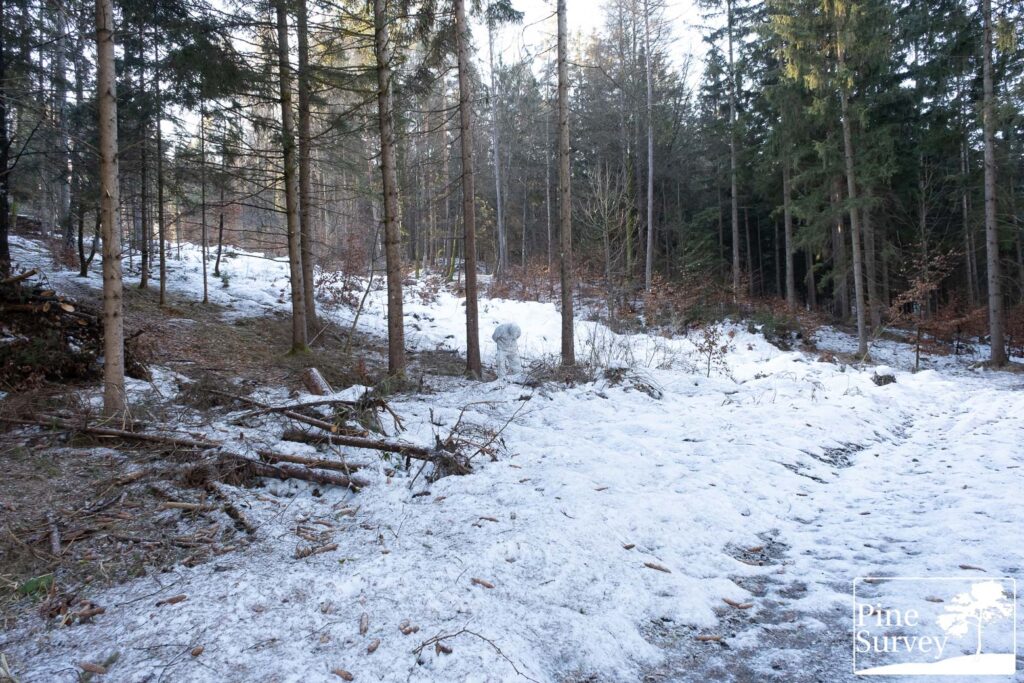
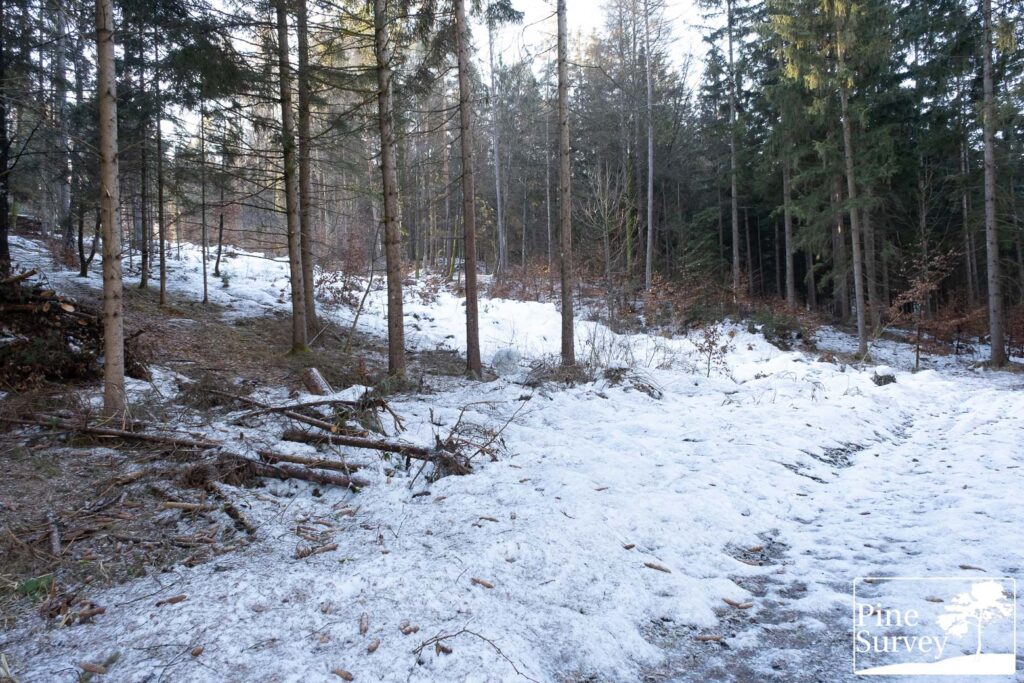
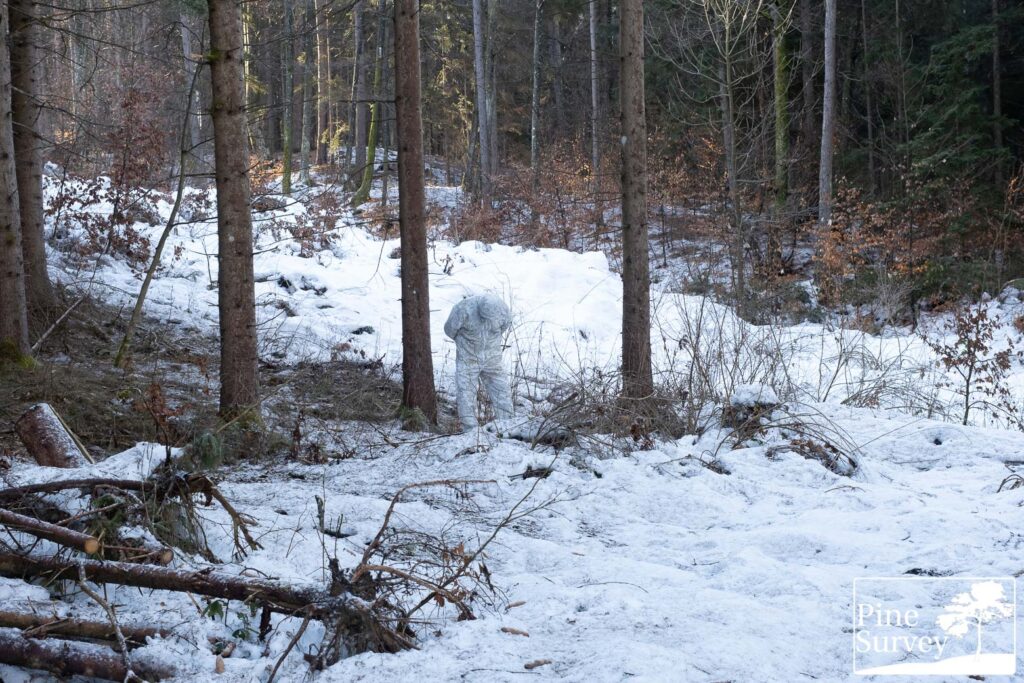
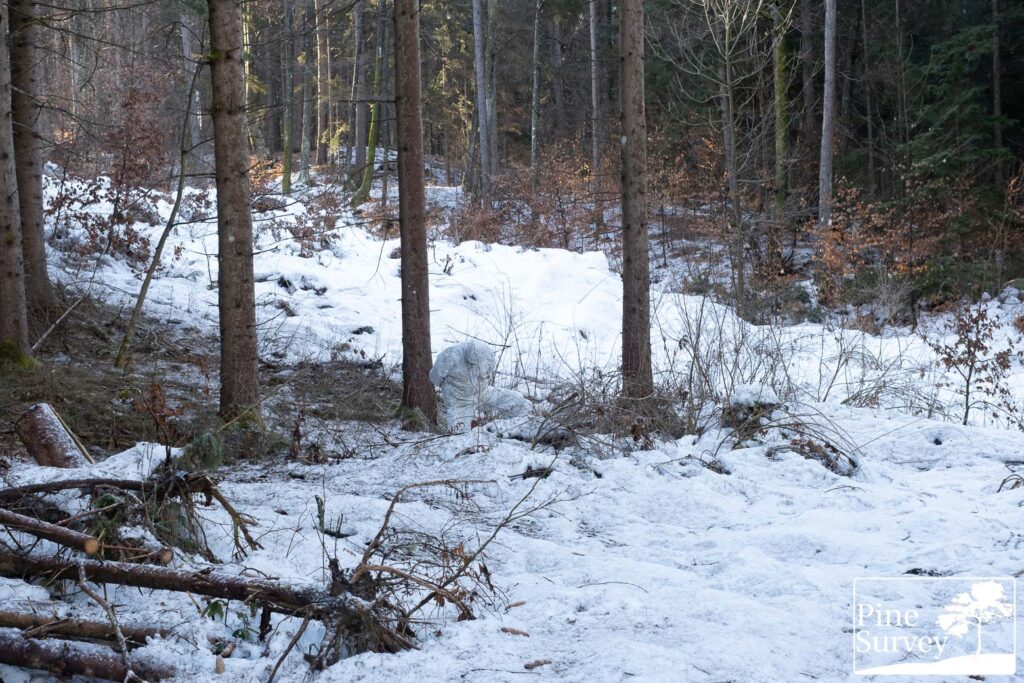
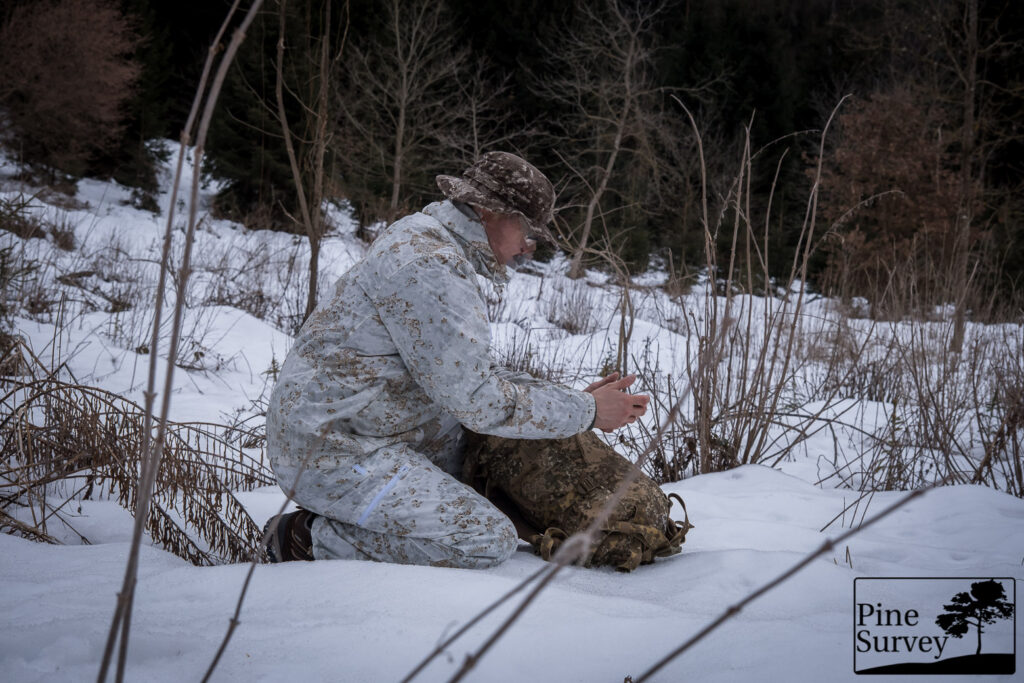

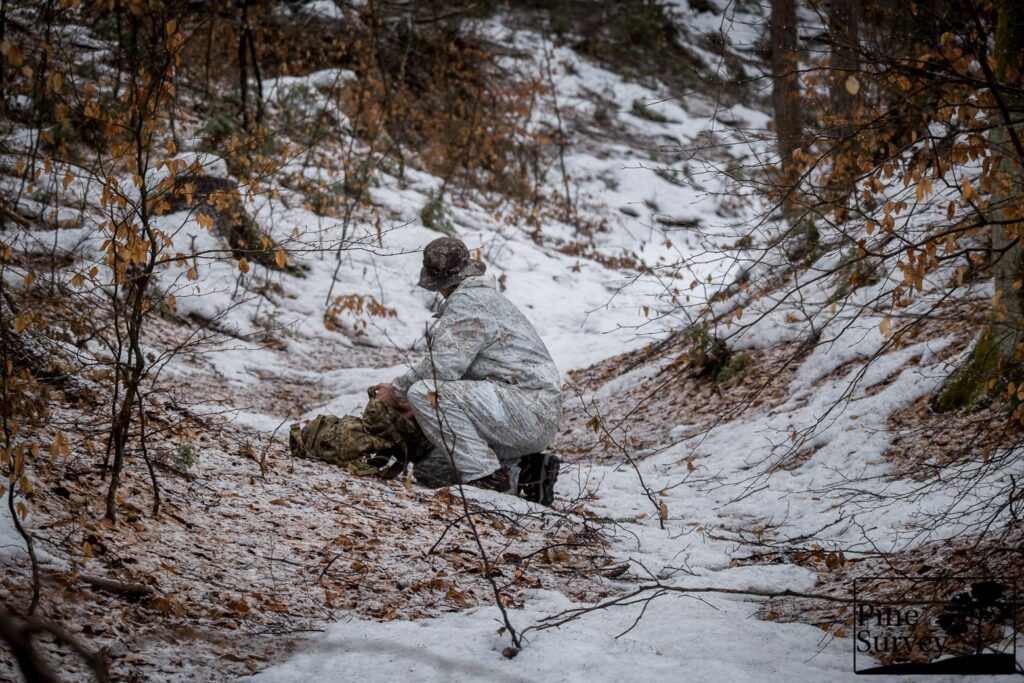
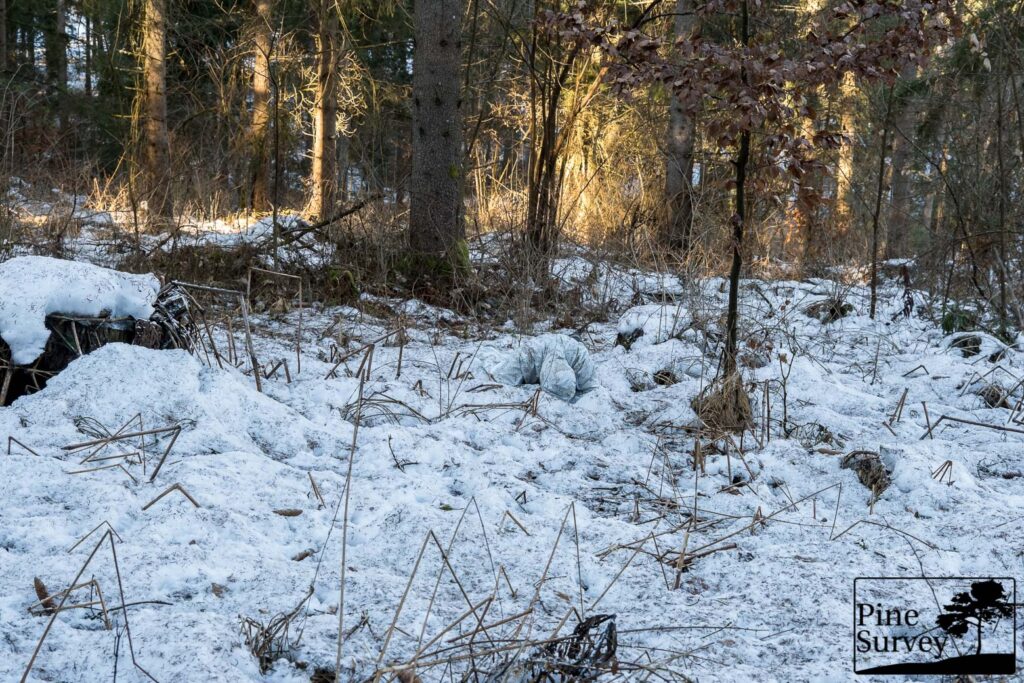
No Comment
You can post first response comment.